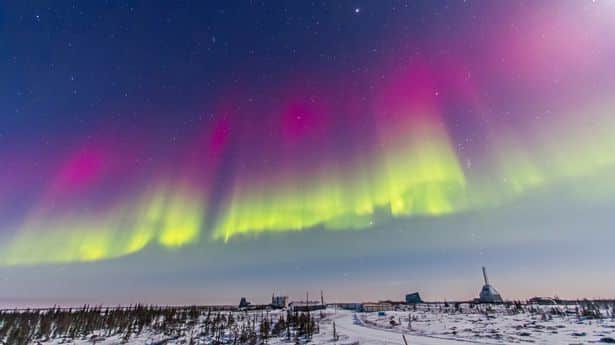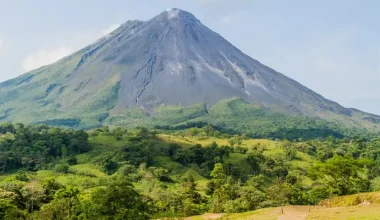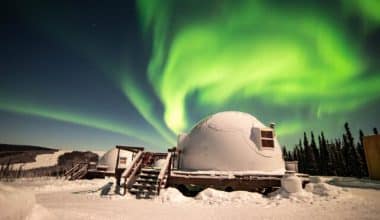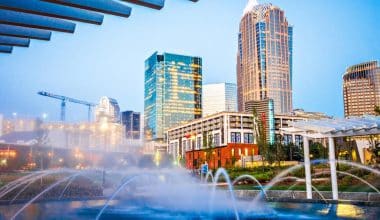The northern lights are one of the most awe-inspiring natural phenomena on Earth. These colorful curtains of light dance across the night sky, and they’re a sight that you’ll never forget. But where can you see the northern lights? The answer depends on a few factors, including the time of year, the strength of the solar activity, and your location.
In this article, we’ll take you on a tour of the best places to see the northern lights. We’ll also share some tips on how to increase your chances of seeing them.
So, without further ado, let’s get started.
Where in the World Is the Best Place to See the Northern Lights?
There is no single location widely acknowledged as the best place to see the northern lights. The strongest light displays, however, occur within the “auroral oval”: a rough circle around the Earth’s magnetic north pole that occurs around 60 to 70 degrees latitude. The oval’s exact size varies, but certain locations typically fall within it.
Central and northern Alaska; large areas of Yukon, the Northwest Territories, and northern Quebec in Canada; southern Greenland; Iceland; and far northern Norway, Sweden, and Finland are among these locations.
Within these areas, it could be argued that Iceland is the best place to see the aurora because the temperatures are much milder than in other areas of the oval. However, this is subjective, and some visitors may prefer a location such as Yellowknife, Canada, for a full-on, bitterly cold Arctic experience.
What Time of Year Is Best to See the Northern Lights?
The northern lights are only visible when it is dark, and because many of the best places to see them are so far north that they have near-constant daylight in the summer, you’ll want to travel between late August and early April. However, there is some debate about the best time to catch the lights during this time period. On the one hand, the aurora tends to be more active around the September and March equinoxes – but on the other hand, your chances of seeing them may be higher in the dead of winter because there is more darkness and thus a longer window in which they may appear.
It may be possible to see the light show in more southern locations, such as Minnesota, during the summer months, but it is still best to go when the nights are longer. It may also be worthwhile to plan your northern lights trip during a new moon: while the aurora can be seen through the moonlight, it may be more difficult to see during a full moon.
Even if you go at the right time of year, cloudy weather can prevent you from seeing the aurora. As a result, it’s a good idea to look into the local weather patterns at your chosen destination to see if there’s a month when you can expect clearer skies.
Is It Better to See the Northern Lights in Iceland or Norway?
Both of these countries can provide spectacular views of the northern lights. They are both directly beneath the typical auroral oval, making them excellent locations. However, there are some distinctions to be made.
To see the aurora in Norway, head to the north of the country: while they have been seen in Oslo, the capital and largest city, it is too far south to be a reliable vantage point. Cities such as Troms are popular, but direct flights are only available from a limited number of European cities, so North Americans will most likely have to connect through Oslo. Iceland, on the other hand, is much easier to reach, with direct flights to its capital, Reykjavik, from a large number of US destinations (particularly on the country’s east coast).
Because clear skies are required to see the northern lights, you may want to base your decision on which location has better weather. Reykjavik has statistically slightly more frequent clear skies from October to December and in March, while Troms may be better in January and February, but the difference is small. Reykjavik also has slightly warmer weather, which, combined with the ease of access, gives it a slight advantage over Norway for viewing the northern lights.
Is It Better to See the Northern Lights in Iceland or Alaska?
Because both Alaska and Iceland are known for spectacular aurora light shows, choosing between them may come down to which destination is more convenient and appealing to you. In Alaska, Fairbanks is regarded as the best place to see the northern lights (though they can still be seen elsewhere in the state, such as Anchorage). Fairbanks has the advantage of not requiring a passport, but there aren’t many direct flights from the lower 48 states. Despite being an international destination, Iceland may be more accessible (especially from the east) thanks to relatively frequent flights to Reykjavik from a variety of American cities.
Fairbanks does have statistically better weather for Aurora viewing than Reykjavik, especially in March, when the Alaskan city sees them around 45 percent of the time (compared to about 25 percent for Reykjavik). However, you must be able to tolerate the cold. While temperatures in Reykjavik hover around freezing in the middle of winter, Fairbanks is a veritable deep freeze, with average highs around 6 degrees Fahrenheit in December and lows around minus 5.
Best Places to See the Northern Lights
#1. Tromsø, Norway
Troms, located 220 miles above the Arctic Circle, is one of several top places in Norway to see the northern lights. The sun does not rise in this northern part of the country during the darkest part of the aurora season (September to March), though there is twilight during the day. Because of the extreme darkness, there are more chances to see the aurora.
When you’re not looking up at the sky, there’s plenty to see and do in Troms, including a visit to the beautiful Arctic Cathedral. The city hosts the Northern Lights Festival, a multiday music and performing arts event featuring a variety of musical genres from late January to early February.
Aurora chasers can see the lights while in town, but for a better view, head away from the city lights with Arctic Circle Tours' guided trips or go on an exhilarating husky trekking expedition in the Arctic wilderness. If you're staying for a few days, book a room with a view of the harbor at the Scandic Ishavshotel.
#2. Fairbanks, Alaska
Fairbanks, located directly beneath the auroral oval, is by far one of the best places in the world to view the northern lights. This ring-shaped zone is located over the Earth’s geomagnetic North Pole, and it is a hotspot for aurora activity. During the aurora season, which runs from August 21 to April 21, visitors can expect to see the lights on four out of every five clear nights.
Other late-summer activities include a ride on the Riverboat Discovery and gold panning. In the winter, visit the Santa Claus House at the North Pole (about 15 miles southeast of Fairbanks) for a festive holiday experience. Visitors can also see ice sculptures at the impressive World Ice Art Championships in February and March or go on a dog-sledding or snowmobiling tour.
Book a private igloo at Borealis Basecamp, a top glamping resort located on 100 remote acres of boreal forest about 30 miles from Fairbanks, for excellent chances of seeing the Northern Lights. You can also book a northern lights tour to see the aurora from Chena Hot Springs Resort's springs and tubs. This tour includes round-trip transportation from town to the resort, a soak in the hot springs, a visit to the Aurora Ice Museum, and an aurora viewing tour with hot beverages.
#3. Orkney, Scotland
This captivating group of islands, located about 10 miles off Scotland’s remote northern coast, is one of the best places in the UK to see the northern nights. The best seasons to see the aurora, also known as the “Mirrie Dancers” in the local Shetland dialect, are fall and winter. This time of year brings cold, dark evenings, which make for ideal viewing conditions if the sky is clear. The spectacular light show can be seen along the coast at Birsay or on the beach at Dingieshowe.
In addition to the aurora borealis, Orkney is home to breathtaking coastal landscapes and an abundance of sheep. Visitors can also visit the Heart of Neolithic Orkney, a UNESCO World Heritage Site with several 5,000-year-old monuments. Plan to stay in the historic town of Kirkwall, the capital of the Orkney Islands, during your visit: The Kirkwall Hotel offers harbor views. Close to town, look for the aurora at Inganess Bay and Wideford Hill.
#4. Lapland, Finland
Lapland is located in northernmost Finland, within the Arctic Circle. The northern lights are most visible here between the end of August and April – and about 200 times a year – so there are plenty of chances to see them. Finnish Lapland is also known as the home of the Sámi people (the only recognized Indigenous group in the European Union region), 200,000 reindeer, and Santa Claus, who can be seen in Rovaniemi.
Watch the impressive light show from a glass igloo at Santa’s Hotel Aurora in Luosto for a bucket list experience. This resort town is located approximately 70 miles north of Rovaniemi, in the picturesque and hilly landscape of Pyhä-Luosto National Park.
You can also spend a magical evening outdoors under star-filled skies on a reindeer-drawn sleigh ride through the snow-covered forests while you’re there. The 2.5-hour “Seeking the Northern Lights With Reindeer” sleigh ride from Jaakkola Reindeer Farm includes a stop to warm up at a bonfire camp with snacks, hot beverages, and local fireside stories.
#5. Yellowknife, Canada
Yellowknife, the capital of Canada’s Northwest Territories, is also known as the “Aurora Capital of North America,” thanks to its location in the center of the auroral oval, which puts on one of the world’s most awe-inspiring light shows, with the best time to see the aurora being from mid-November to the beginning of April. The aurora can also be seen from late summer to early fall, as the lights are visible up to 240 days a year.
Yellowknife, located on the northern shore of Great Slave Lake, offers winter activities such as ice fishing and cross-country skiing. Plan to attend the month-long Snowkings’ Winter Festival in March, which includes events and activities such as a snow-carving competition, an ice slide, a snow castle, live music, and more.
Book a tour or package through Aurora Village to view the lights for a one-of-a-kind experience. The property will pick you up from your hotel and transport you to its location, where you will be able to stay warm in a tent while sipping hot beverages. Aurora Village, which is owned by Aboriginal people, also provides activities such as dog sledding and snowshoeing excursions.
#6. Reykjavik, Iceland
The best time to see the aurora borealis in Iceland is from October to March. Throughout the country, there are numerous natural parks and attractions where you can see the show during the long and dark winter, but the capital city of Reykjavik also has many options for accommodations, restaurants, and other activities for your visit. Skjuhli is the best place to see the Northern Lights away from light pollution. This wooded and hilly area in Reykjavik is 200 feet above sea level and has walkways and paths from which to view the nighttime show.
On top of this forest is Perlan, which houses the country’s only planetarium and a museum with exhibits about Iceland. Perlan also has the world’s first indoor ice cave and glacier exploration center. Don’t miss the panoramic views of the city from the building’s fourth-floor observation deck during your visit. From this vantage point, you can see the Snaefellsjökull glacier, Keilir, a volcanic mountain, and Esja, Reykjavik’s mountain.
Splurge on an overnight tour with Buubble Tours while in Reykjavik. This experience includes several sightseeing stops as well as a night spent in a bubble under the magical northern skies at the 5 Million Star Hotel.
#7. Jukkasjärvi, Sweden
The best time to see the illuminated skies in Sweden’s northernmost region, Swedish Lapland is between early September and late March. Jukkasjärvi, a small Swedish village on the Torne River about 125 miles above the Arctic Circle, is an excellent location for viewing the Northern Lights. The village’s origins date back to the 17th century, and some of the original homesteads, including an old timber cottage, can still be found. The village now has 800 residents and over 1,000 dogs.
If you’re up for a chilly overnight adventure, book a room at the world’s first permanent ice hotel, Icehotel 365. Each of its artist-designed suites is sculpted from ice and has a distinct theme, with temperatures hovering around minus 5 degrees Celsius (about 23 degrees Fahrenheit). The rooms also have beds with reindeer hides and thermal sleeping bags to keep you warm at night. While you’re there, go on a guided northern lights tour by snowmobile or go on a moose safari atop an Icelandic horse.
#8. Kangerlussuaq, Greenland
Greenland may not be the easiest place to visit to see the northern lights, with few flight options, but those who do make it here will be glad they did. From September to early April, the tundra of Kalaallit Nunaat (the Greenlandic name for the country) is one of the best places on the planet to see the aurora.
For the more daring aurora hunters, the top of the Greenland Ice Cap provides spectacular views of the lights. This impressive glacier covers 80% of the country and can be reached via the tiny town of Kangerlussuaq. The town, which is located on a fjord right along the Arctic Circle, is often described as a gateway to Greenland and was a former U.S. Greenland’s busiest airport is now located on an Air Force base.
#9. Viking Ocean Cruise Along Norway’s Coast
Embrace winter and set sail for the Arctic Circle to witness the Northern Lights in northern Norway. This 13-day cruise itinerary departs from London for the North Sea, with stops in top aurora viewing locations such as Troms, Alta, and Narvik. The cruise comes to an end in Bergen.
While on land, enjoy the natural beauty of the snow-covered landscapes and book bucket list excursions such as a night in an igloo or a reindeer sledding adventure. You can also chase the lights into the wilderness by snowmobile, take a dog-sled ride under the stars, or watch them from atop the mountain from a Sámi tent.
#10. Headlands International Dark Sky Park, Michigan
Headlands International Dark Sky Park, located at the top of Michigan’s lower peninsula, less than 5 miles from Mackinaw City, is regarded as one of the best places in the country to see the aurora. While the northern lights are difficult to predict due to their southern location, the best time to see them is usually in the spring and fall – and experts at the park recommend that visitors face north after midnight for the best chance of seeing the show. The park even keeps an online Clear Sky Chart so you can check the weather forecast before heading out.
Other stargazing opportunities are available at Headlands throughout the year. The Milky Way is visible across the sky during the summer months, and meteor showers entertain visitors on late summer evenings. Spend a night at the Mission Point Resort on Mackinac Island if you’re visiting between late April and the end of October. This iconic property on Lake Huron’s shoreline also offers a variety of outdoor activities, such as bike rentals and swimming.
#11. Voyageurs National Park, Minnesota
Voyageurs National Park is a 218,000-acre labyrinth of boreal forests, lakes, and streams located on the international border of Minnesota and Ontario. It is Minnesota’s only national park; it’s also unique in that the park’s interior is only accessible by water for much of the year. Voyageurs, as a certified International Dark Sky Park, offers opportunities to view the Milky Way on clear evenings, particularly during the summer. Year-round aurora viewing is possible on clear dark nights, but the best time to see the show is during the winter when it is darker for longer.
Voyageurs Outfitters can provide a custom-guided tour of the nighttime lights display, including the Milky Way and constellations. If you’re on your own, park officials say almost any campsite is a good place to see the northern lights and stargaze. For spectacular views, visit the boat launch areas near Ash River, Kabetogama Lake, and the Rainy Lake Visitor Center.
Those who would rather sleep in a warm, cozy bed than under the stars in the park can make reservations at the Cantilever Distillery + Hotel, a boutique Trademark Collection by Wyndham property in the nearby town of Ranier, Minnesota.
#12. Saadjärv, Estonia
Several destinations in Estonia are popular with local aurora chasers, but Saadjärv is one of the best bets for reliable sightings. The town is located in Tartu County, central Estonia, about 15 miles north of Tartu. It is located in a rural area on Lake Saadjärv, one of the country’s ten deepest and largest lakes.
Saadjärv is also close to the Vooremaa Landscape Reserve, so when you’re not watching the lights dance in the sky, there’s plenty to do in the area. Lake Saadjärv is a popular recreational area with beaches and nearby cultural sites and museums like the Ice Age Centre. You can also go snowshoeing in the Männikjärve bog or explore the Elistvere Animal Park. Plan an extended stay at Hotel Antonius, a beautiful boutique hotel in the heart of Tartu’s historic district.
#13. Abisko National Park: Sweden
Given its Arctic location, Sweden is one of the best places in the Northern Hemisphere to see the northern lights, with Swedish Lapland at the top of the list. Because there is more darkness than light during the day, the fall and winter months (November to March) provide the best opportunities to witness the spectacle.
If you’re looking for an Arctic adventure, December is a great time to visit Abisko National Park, which some consider to be one of the best places on Earth to watch the Northern Lights dance across the sky. The park’s mountainous terrain and clear dark skies provide spectacular front-row views of the northern lights. The Aurora Sky Station is one of the best places in the park to see the aurora, and experts are available to answer questions about the science behind this fascinating phenomenon.
Professional photographers and aurora-chasing guides at Visit Abisko lead three- to four-hour tours throughout the fall and winter if you prefer to chase the lights with a curated tour. If possible, try to join the tours in October or November, as this time of year provides a unique opportunity to see the lights in the sky as well as reflected in the lakes and rivers, which you won’t see if you visit in the winter.
#14. Nellim, Finland
Due to the lack of light pollution, this remote Arctic destination located less than 10 miles from the Russian border in Finnish Lapland is a top-rated location to view the northern lights. Between December and March is the best time to visit.
The Nellim Wilderness Hotel provides the ideal base for further exploration of the region, with year-round activities such as aurora-chasing tours. Visitors can view the aurora by car, snowmobile, or snowshoe. You can even take a sleigh ride through the snow to a campsite on Lake Inari, where there is no light pollution, making it one of the best places in the world to see the aurora.
The property has rooms, suites, and villas for guests to stay in. The Nellim Wilderness Hotel also has aurora-focused “kotas” (inspired by traditional Sámi huts), log cabins, and bubble-shaped accommodations for two, where guests can watch the dancing lights from the warmth of their warm, cozy beds. The Aurora Bubbles has a glass roof that looks out into the night sky directly above the bed. When you’re not chasing the Northern Lights, try a husky safari, ice fishing, snowmobiling, or a day in the snow with the local reindeer.
#15. Saariselkä, Finland
Saariselkä is Finland’s northernmost ski resort, located about 150 miles above the Arctic Circle along the road to the Arctic Sea. This region of Finnish Lapland is famous for its breathtaking scenery, Sámi culture, cross-country and downhill skiing, and Urho Kekkonen National Park, one of Finland’s largest parks.
The resort village is also one of the best places in the world to see the northern lights because it is located within the auroral oval, and there are up to 200 opportunities to see the show each year. The best time to see the aurora is from March to early April, according to the Finnish Meteorological Institute, because the weather is usually better at this time of year. However, the northern lights can be seen at any time of year, from late August to early or mid-April.
Saariselkä is also famous for its glass igloos, which are ideal for snuggling up and staying warm while watching the northern lights. The Kakslauttanen Arctic Resort offers two- and four-person igloos for rent. This property also has Kelo-Glass Igloos, which combine the comforts of a log chalet with the transparency of a glass roof. Year-round tours and activities are also available, including northern lights excursions on snowmobiles or horse-drawn carriages.
#16. Tasmania
Tasmania is about 150 miles south of Australia, separated from the mainland by the Bass Strait. Because of its latitude and moderate seasonal and light changes, the mountainous island is one of the few places on the planet where the aurora can be seen 365 days a year.
The capital city of Hobart, which is home to the island’s largest airport, is the most convenient point of entry and can serve as a convenient base. There’s also plenty to see and do in the city’s burgeoning food and cultural scenes. You can get to several great viewing spots with unobstructed and open views along the southern and southeast coastlines from here, including Goat Bluff and Carlton Beach.
Make a reservation at The Tasman, a Luxury Collection Hotel in Hobart, for your stay. The historic luxury property is located near the ferry terminal along the lively waterfront area. When you’re not staring at the night sky, treat yourself to a one-of-a-kind helicopter ride with Tasmanian Air Tours. Depending on your preferences, your private pilot can whisk you away to soar over the sea cliffs, visit a local winery to sample local vintages, or head south to Port Arthur, Tasmania’s historical and most notorious prison.
#17. Stewart Island, New Zealand
Despite their remoteness, some far-south destinations offer the opportunity to witness the aurora australis or southern lights. While you can see them all year (just like the northern lights), certain months in the Southern Hemisphere are better for aurora viewing. Stewart Island is regarded as one of the best places in New Zealand to see the brilliant display, with Rakiura National Park covering 85% of the island, so there are few people and almost no light pollution. It is the country’s southernmost populated island. Stewart Island can be reached by flying into Oban or taking a ferry from Invercargill or Bluff.
The southern lights are best seen in New Zealand during the winter months of June to August, but they can also be seen in the spring (September to November) and fall (March to May). The brighter summer months of December and February make spotting the aurora more difficult, but there’s still a chance you’ll catch a glimpse of the lights between midnight and 4 a.m.
Reserve a room with a view of Halfmoon Bay and the Foveaux Strait at Stewart Island Lodge, an intimate bed-and-breakfast, for your aurora-chasing adventure. This lovely property is only a few minutes walk from Oban village, and the property will pick you up from the airport or ferry terminal for your stay.
Related Articles
- BEST GAMING PC BRANDS: Top Gaming PC Companies To Know 2023
- Student Finance: Grants, Loans, Applications (+ How to Start Guide)
- When Is the Best Time to Visit Iceland? All You Should Know
- Student Loans Company Guide: All You Should Know (+ free tips)
- What Are the Northern Lights? All You Should Know






